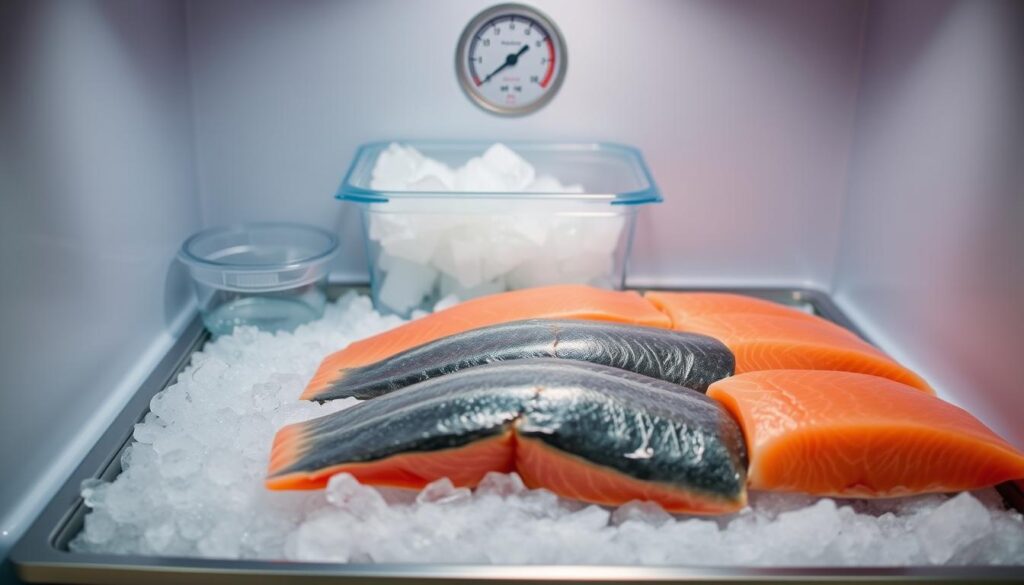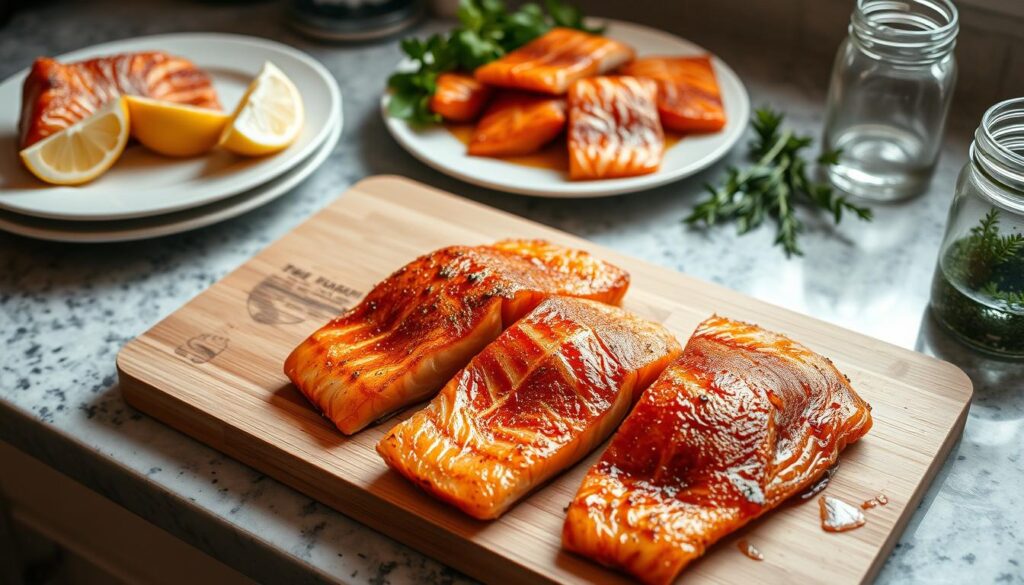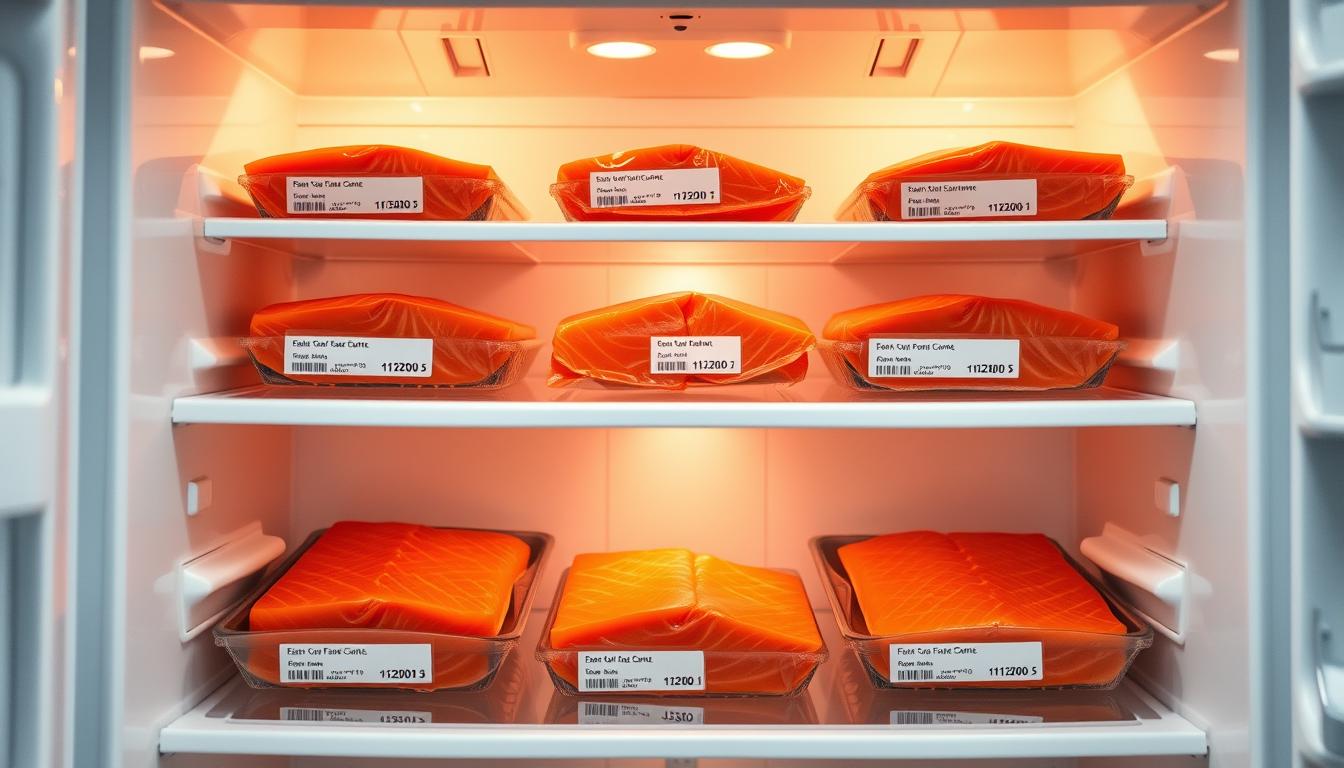How Long Is Salmon Good in the Fridge? Storage Guide & Tips
Every home cook worries about whether their salmon is safe to eat. I’ve learned that knowing about salmon food safety is key. It’s not just about saving food, but also keeping your family healthy and enjoying great meals.
Figuring out how long salmon stays good in the fridge can be tricky. Whether it’s wild-caught Alaskan or farm-raised, storing it right is important. It keeps the salmon fresh and prevents foodborne illnesses.
This guide will make salmon storage easy to understand. You’ll learn how to keep your seafood fresh, safe, and delicious. We’ll cover raw and cooked salmon, with tips to make your meals tasty and safe.
Table of Contents
Understanding Salmon Storage Basics
Keeping salmon fresh is key for its quality and safety. The shelf life of raw salmon depends on storage method, temperature, and initial freshness.
Different salmon types need specific storage to stay fresh and prevent bacteria. Your storage plan changes based on whether it’s fresh, smoked, or cooked.
Types of Salmon and Their Storage Requirements
- Fresh Raw Salmon: Store in the coldest part of your refrigerator
- Smoked Salmon: Requires sealed packaging and lower temperature zones
- Cooked Salmon: Must be refrigerated within two hours of cooking
Importance of Proper Temperature Control
Keeping the right temperature is vital for salmon’s quality. Your fridge should stay below 40°F to stop bacteria growth and keep raw salmon fresh longer.
| Salmon Type | Refrigerator Storage Time | Optimal Temperature |
|---|---|---|
| Fresh Raw Salmon | 1-2 days | 32-38°F |
| Cooked Salmon | 3-4 days | Below 40°F |
| Smoked Salmon | 5-7 days | 34-38°F |
Impact of Storage Methods on Freshness
Your storage method greatly affects salmon’s texture, taste, and safety. Vacuum-sealed packaging can keep it fresh longer by reducing oxygen and stopping bacteria.
Knowing these storage basics helps keep your salmon tasty and safe. This way, you get to enjoy its quality and flavor more.
How Long Is Salmon Good in the Fridge
Knowing how long salmon stays fresh in the fridge is key for food safety and quality. The freshness of your refrigerated salmon depends on several important factors.
Raw salmon has a short fridge life. It stays fresh for 1-2 days when stored right. You should cook or freeze it fast to avoid spoilage.
Cooked salmon gives you a bit more time. You can keep it in the fridge for 3-4 days. To keep your salmon fresh, follow these tips:
- Always store salmon in an airtight container
- Keep refrigerator temperature below 40°F
- Place salmon on the coldest shelf of your refrigerator
- Wrap salmon tightly in plastic wrap or aluminum foil
Different salmon types might have slight variations in fridge time. Wild-caught salmon usually has a shorter shelf life than farm-raised. Proper storage can extend your salmon’s fridge life and keep it quality.
Remember, these times are just guidelines. Always check for spoilage before eating refrigerated salmon. This ensures your meal is safe and tasty.
Safe Storage Temperatures and Conditions
Keeping your salmon fresh starts with knowing how to store it right. Salmon food safety depends on the right storage environment. This prevents bacterial growth and keeps it fresh.
Your fridge is key to keeping salmon fresh. It’s all about the right temperature and conditions. This keeps your fish safe and tasty.
Optimal Refrigerator Temperature Settings
Temperature is key for salmon safety. Here are the must-knows:
- Keep the fridge at or below 40°F (4°C)
- Use a thermometer to check the temperature
- Stay away from temperature changes that harm the fish
Best Storage Locations in Your Fridge
Not all fridge spots are the same for salmon. Here are the best places:
- Bottom shelf: It’s the coldest and most stable
- Back of the fridge: It’s away from door openings
- Don’t store near warm spots or sensitive areas
Humidity Control Tips
Managing humidity is key for salmon quality. Wrap it in moisture-resistant paper or use an airtight container. This stops excess moisture and bacterial growth.
Follow these tips for salmon food safety. Your fish will stay fresh, tasty, and safe to eat.
Proper Packaging Methods for Salmon
Storing salmon right is key to keeping its taste and quality. It’s important to keep it away from air and contamination. This helps keep it fresh and safe to eat.
- Use airtight containers to keep air out
- Wrap it tightly in plastic wrap or foil
- Choose containers with tight, leak-proof seals
- Make sure containers fit the salmon perfectly
Raw and cooked salmon need different packaging. Raw salmon needs extra care to stop bacteria and keep its soft texture.
| Packaging Type | Best For | Storage Duration |
|---|---|---|
| Vacuum-sealed bags | Raw salmon | Up to 2 days |
| Glass containers | Cooked salmon | 3-4 days |
| Plastic wrap | Short-term storage | 1-2 days |
To keep salmon fresh, remove air before sealing. This step stops oxidation and keeps salmon ready for cooking or later enjoyment.
Signs of Spoiled Salmon
It’s important to know how to spot salmon spoilage to stay healthy and enjoy tasty meals. Salmon can spoil fast, so it’s key to recognize the signs of bad quality.
Fresh salmon should look and smell good. When it starts to spoil, you’ll notice clear signs.
Visual Indicators of Spoilage
Your eyes can tell a lot about salmon’s freshness. Look out for these signs:
- Discoloration from bright pink to dull gray or greenish hues
- White or gray film developing on the surface
- Visible mold patches
- Dull, dry appearance instead of a moist, shiny surface
Texture Changes to Watch For
Texture is also a key sign of salmon spoilage. Keep an eye out for these changes:
- Slimy or sticky surface feeling
- Mushy or overly soft texture
- Separation of muscle fibers
Smell Test Guidelines
Your nose is great at detecting spoiled salmon. Fresh salmon should smell mild and ocean-like. Beware of these smell warnings:
- Strong, sour, or ammonia-like odor
- Fishy smell that’s overwhelming or unpleasant
- Rancid or putrid scent
If your salmon doesn’t smell right, it’s best to throw it away. This keeps you safe and healthy.
Extending Salmon Shelf Life

To keep salmon fresh longer, use smart refrigeration methods that focus on food safety. The way you store your fish greatly affects its freshness and taste.
Here are some top tips to keep your salmon fresh:
- Store salmon in the coldest part of your fridge, usually the back of the bottom shelf
- Keep it in an airtight container to stop moisture loss and bacterial growth
- Wrap it tightly in plastic wrap or vacuum-sealed bags
- Keep the fridge at 32-38°F for the best preservation
Pro tip: Fresh salmon lasts 1-2 days in the fridge if stored right. Proper packaging and keeping the right temperature are key for quality and safety.
How you store salmon affects its taste, texture, and safety. Using these expert storage tips helps reduce waste and keeps your salmon fresh, tasty, and safe to eat.
Don’t forget to check your salmon regularly. If it smells bad, feels slimy, or looks off, throw it away to stay healthy.
Freezing Salmon for Long-Term Storage
Freezing salmon is a great way to keep it fresh for a long time. It’s perfect for those who love cooking at home and want to enjoy fresh fish for months.
To keep salmon’s taste and nutrients, freeze it when it’s at its best. Knowing how to freeze it right helps keep its texture and flavor.
Freezing Methods for Maximum Freshness
- Wrap salmon tightly in freezer-grade plastic wrap
- Use vacuum-sealed bags to prevent freezer burn
- Remove as much air as possible before sealing
- Label packages with the date of freezing
Freezing Timeline and Storage
| Salmon Type | Freezer Storage Time | Quality Preservation |
|---|---|---|
| Fresh Whole Salmon | 3 months | Excellent |
| Salmon Fillets | 2-3 months | Very Good |
| Cooked Salmon | 1-2 months | Good |
Thawing Techniques
Ready to thaw your frozen salmon? Here’s how to do it safely:
- Transfer salmon from freezer to refrigerator
- Allow 24 hours for gradual thawing
- Cook within 1-2 days after thawing
- Never thaw salmon at room temperature
By sticking to these guidelines, you can enjoy salmon that’s just as good months later. You’ll get to enjoy tasty meals without losing any of the flavor or nutrition.
Storing Different Types of Salmon
Not all salmon is the same when it comes to storage. Raw salmon’s shelf life changes based on its type and how it’s prepared. Knowing these differences helps keep your food fresh and safe.
Salmon types need different storage methods. Your plan will depend on whether it’s raw, cooked, or processed.
- Raw Salmon: Store in the coldest part of your fridge. It lasts 1-2 days before cooking.
- Cooked Salmon: Keep it in the fridge for 3-4 days in a sealed container.
- Smoked Salmon: Unopened, it lasts 2 weeks in the fridge. Opened, eat within 5-7 days.
- Canned Salmon: Store unopened cans at room temperature. Once opened, refrigerate and eat in 3-4 days.
For cooked salmon, use airtight containers and refrigerate within two hours of cooking. This keeps it fresh and prevents bacteria.
Pro tip: Always check for spoilage before eating salmon. It should smell like the ocean and feel firm and glossy.
Best Practices for Cooked Salmon Storage
Storing cooked salmon right is key to keeping its taste and ensuring food safety. Proper handling can make your salmon last longer and avoid food sickness.

After cooking your salmon, follow these important tips to keep it fresh and safe.
Cooling Methods Before Storage
Cooling cooked salmon fast is very important. Here are some good ways to do it:
- Cool salmon at room temperature for no more than 2 hours
- Divide large portions into smaller containers for faster cooling
- Use shallow dishes to help salmon cool quickly
- Refrigerate salmon within 2 hours of cooking
Container Selection Guidelines
Picking the right container is key to keeping salmon quality and avoiding contamination.
| Container Type | Pros | Cons |
|---|---|---|
| Airtight Glass Containers | Non-reactive, easy to clean | Heavier, more expensive |
| Plastic Food Storage Containers | Lightweight, affordable | May absorb odors, possible chemical leaching |
| Vacuum-Sealed Bags | Minimizes air exposure | Single-use, needs special equipment |
Reheating Safety Tips
When reheating salmon, remember these safety tips:
- Reheat to an internal temperature of 165°F (74°C)
- Use a food thermometer to check temperature
- Consume reheated salmon within 3-4 days of initial cooking
- Avoid reheating multiple times
By following these cooked salmon storage tips, you’ll keep your seafood tasty and safe to eat.
Storage Guidelines for Marinated Salmon
Marinating salmon makes it taste amazing, but you must pay attention to food safety. To keep your salmon fresh and tasty, follow some important storage tips.
Understanding the short shelf life of marinated salmon is key. Raw marinated salmon should stay in the fridge and be eaten within 1-2 days. Start storing it right after you add the marinade.
- Use clean, non-reactive containers for marinating
- Always marinate salmon in the refrigerator
- Keep marinated salmon covered tightly
- Avoid leaving marinated salmon at room temperature
Keeping the right temperature is vital for storing marinated salmon. Your fridge should be at 40°F or lower to stop bacteria from growing. Never leave marinated salmon sitting out for more than 2 hours, as this increases the risk of foodborne illness.
| Marination Type | Refrigerator Storage Time | Safety Recommendation |
|---|---|---|
| Acidic Marinades | 30 minutes to 2 hours | Cook immediately after marinating |
| Non-Acidic Marinades | Up to 24 hours | Do not exceed 2 days total storage |
Before cooking your marinated salmon, always check it first. Look for any signs of spoilage, like bad smells, color changes, or a slimy feel. These signs mean the fish is not safe to eat.
Commercial vs. Home Storage Methods
Professional kitchens and fish markets use advanced fish storage methods. These can greatly improve how you keep fresh salmon at home. Knowing the differences between commercial and home storage can help you keep your seafood at its best.
Professional chefs and seafood experts use special techniques to keep salmon fresh longer. They focus on precise temperature control and strategic preservation methods. This goes beyond simple storage.
Professional Storage Techniques
Commercial kitchens use advanced storage strategies that you can also use at home:
- Industrial-grade refrigeration units with consistent temperature
- Specialized storage containers with airtight seals
- Rapid cooling methods to preserve fish quality
Adapting Commercial Practices for Home Use
You can use professional-level storage techniques in your kitchen with a few adjustments:
- Invest in a high-quality refrigerator thermometer
- Use vacuum-sealed storage containers
- Maintain consistent refrigeration temperatures
Equipment Recommendations
| Equipment Type | Home Use Recommendation | Estimated Cost |
|---|---|---|
| Vacuum Sealer | Extends salmon freshness up to 2 weeks | $50-$150 |
| Digital Thermometer | Ensures precise temperature monitoring | $20-$40 |
| Specialized Storage Containers | Prevents moisture and preserves quality | $30-$80 |
Pro tip: Using these commercial-grade fish storage guidelines can help you keep your salmon fresh and flavorful. It brings restaurant-quality preservation to your home kitchen.
Conclusion
Knowing how long salmon stays good in the fridge is key for keeping food fresh and safe. By using the storage tips you’ve learned, you can keep your salmon fresh longer. This helps avoid health risks.
Salmon safety begins with proper fridge storage, careful packaging, and spotting spoilage signs. Now, you can handle salmon confidently. This ensures every meal is tasty and safe for your loved ones.
Different types of salmon need special storage methods. Whether it’s fresh wild-caught or store-bought fillets, keeping it cool and using airtight containers is vital. This helps keep the salmon’s flavor and nutrients intact.
With these expert tips, you’re ready to store salmon like a pro chef. Your cooking adventures can continue with the knowledge that you’re keeping the taste and safety of this healthy seafood.
FAQ
How long can raw salmon be stored in the refrigerator?
How long is cooked salmon good in the fridge?
What are the key signs that salmon has gone bad?
Can I freeze salmon to extend its shelf life?
How should I store smoked salmon in the refrigerator?
Is it safe to eat salmon that has been in the fridge for a week?
What’s the best way to store marinated salmon?
How can I tell if frozen salmon is stil good?
There are no reviews yet. Be the first one to write one.

